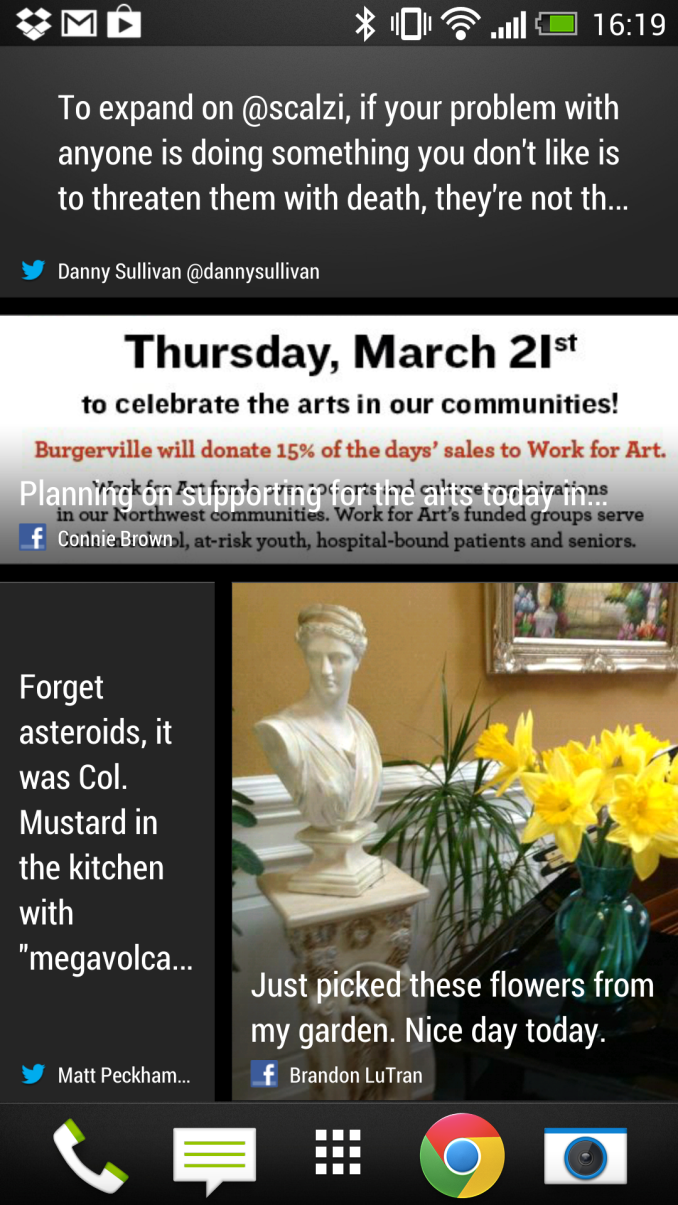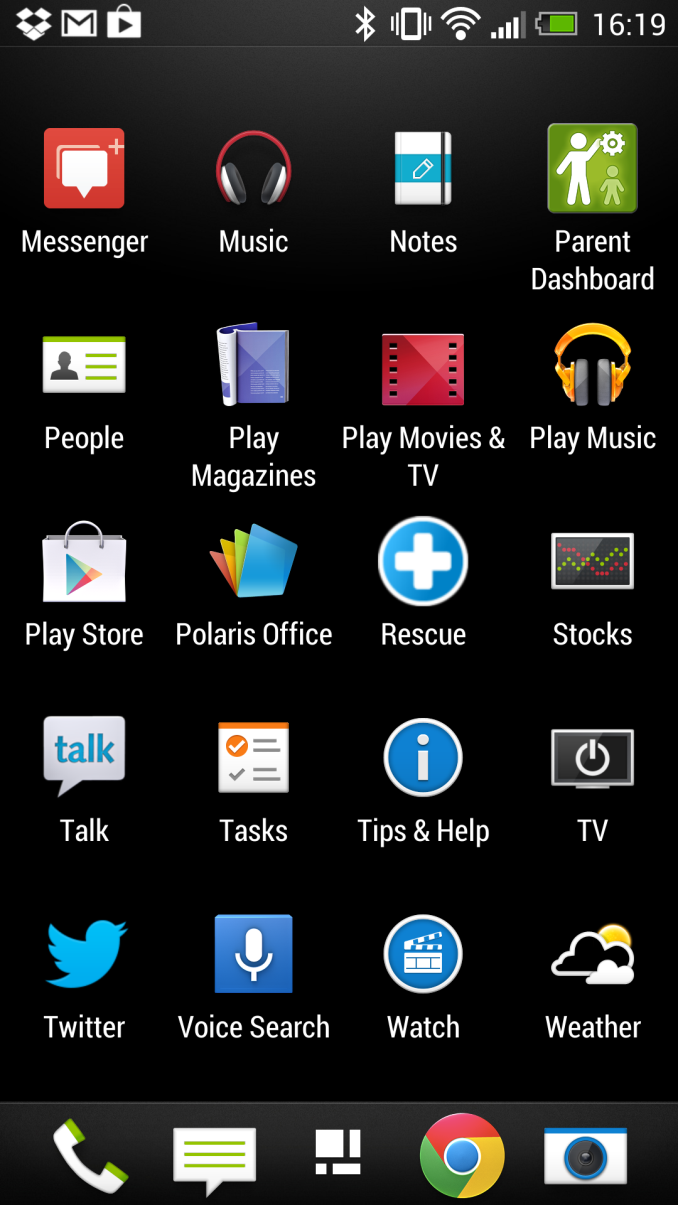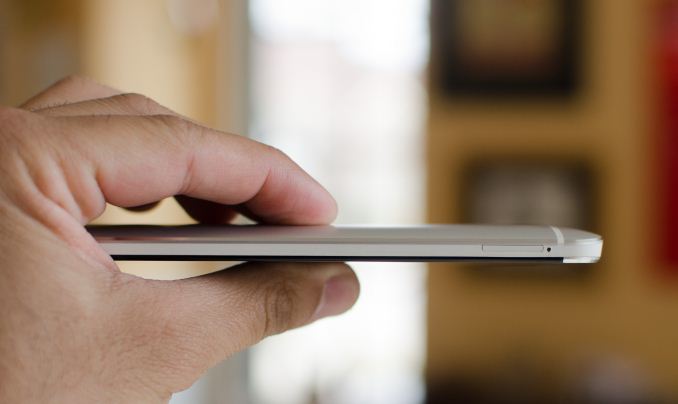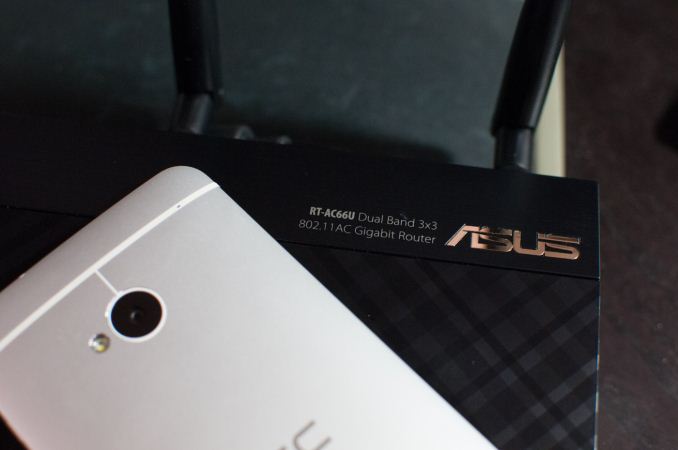The HTC One: A Remarkable Device, Anand’s mini Review
by Anand Lal Shimpi on March 21, 2013 4:49 PM EST- Posted in
- Smartphones
- HTC
- Mobile
- HTC One
Android/Sense
The One ships with Sense 5.0, and I have to say that the latest version of Sense is really the first custom Android skin that I don’t mind. I’m not sold on Blinkfeed, the default homescreen that allows you to aggregate content from multiple web sources as well as Twitter and Facebook, but thankfully you can easily change that default to something more traditionally Android.
With Sense 5.0 HTC dramatically reduced the presence of widgets on the default home screen. Other than the Blinkfeed screen, there’s only a single home screen by default and the only widget on that screen is a Google search box. You can obviously add all of the widgets you want, but this is a noticeable departure from HTC’s strategy in the past. To be honest, it’s a lot cleaner.
Sense 5.0 isn’t intrusive, and the work HTC has done in the gallery app sort of make the customizations worth it (more on this later). Even the default pre-load of apps is very sensible.
Thanks to the underlying use of Android 4.1.2 combined with the fast Snapdragon 600 SoC, UI frame rate is incredibly smooth. Some interactions are still not perfect (e.g. zooming in Google Maps) but the overall experience is very polished and very fast.
Performance & Battery Life
The One is the first Snapdragon 600 based smartphone that I’ve used regularly. For those who aren’t familiar with Qualcomm’s latest branding change, Snapdragon 600 refers to a quad-core Krait 300 based SoC with Adreno 320 graphics (APQ8064T). The SoC still uses the same 28nm LP process as the previous quad-core flagship (APQ8064), but clocks are a bit higher (1.7GHz in the One, 1.9GHz in the Galaxy S 4).
GPU clocks appear unchanged, which is contrary to what I was told at the launch of Krait 300 but it’s entirely possible that we’ll see implementation with higher GPU clocks.
Performance, as I mentioned before, is very good. Even the speed of the NAND HTC used in the device is among the best I’ve seen in Android devices. We’re still not yet at the point where I believe smartphone SoC performance is good enough, but at least we won’t see a huge jump in SoC performance (at similar power) until the move to 20nm in mid to late 2014.
The impact of all of this on battery life, as always, depends on your usage model. I’ve been using the international One on AT&T, and 3G battery life is comparable to the iPhone 5 on the same network (non-LTE) at identical brightness levels. I have yet to see what the difference will be like with LTE enabled.
Obviously with four cores and a larger, higher resolution display, the One definitely has the ability to draw more power than the iPhone 5. Keep the cores more active and/or drive the display at very high brightness levels and you’ll see worse battery life. For the past couple of years I’ve been talking about the increase in dynamic range when it comes to smartphone battery life, the One is no different in this regard. Brian will have a full rundown of battery life data on the One in his review.
Other Frills: Of Big Screens and Usability
For me, the iPhone 5’s display is a little too small, and the One is probably a little too big. I think I agree with Brian here in that the ideal display size is somewhere around 4.3”. That being said, I find both devices (the 5 and the One) to be comfortably usable. The 5 is better for one handed use, while the One is better for actually consuming web content. In pocket, the One is thin enough to not be a problem.
Although it’s probably a bit overkill, I am pleased with the move to 1080p across all of the high end Android smartphones. The One’s display looks excellent and lacks the oversaturated colors of the alternative AMOLED displays.
The One also features stereo speakers that get impressively loud (louder than any other smartphone I’ve used, by a considerable margin). I keep my phone on silent all the time but when showing others highlights reels, the One’s loud stereo speakers definitely come in handy.
The final element of the One that I’m really happy about is the integration of 802.11ac support. The One is good for WiFi speeds of up to 275Mbps (that’s actually tested, not theoretical).














434 Comments
View All Comments
Anand Lal Shimpi - Thursday, March 21, 2013 - link
I gave up removable batteries a while ago. Same thing on the lack of micro SD card slots :)Take care,
Anand
nerd1 - Thursday, March 21, 2013 - link
Why do we need to give up any features? GS4 still offers replaceable battery, packs larger (and personally better) display in much thinner and lighter case.Muyoso - Thursday, March 21, 2013 - link
Pentile AMOLED is a better display to you? Wow.SodaAnt - Thursday, March 21, 2013 - link
I don't think pentile really matters when you have a 5" 1080P screen. The real issue with pentile is that it lowers the effective resolution of the screen, but once you get to the level of DPI that we're seeing it hardly makes a difference.metafor - Thursday, March 21, 2013 - link
People said that about the Galaxy S3's 4.8" 720p screen as well; that you can't notice the pentile matrix. I own one and while it's not terribly distracting, holding it side-by-side with the OneX's LCD is night and day. I don't know how true that is at 1080p and 5" though.nerd1 - Thursday, March 21, 2013 - link
GS3 has 306ppi for green and ~200ppi for red and blue, which are not that terrible but still noticeable. On the other hand GS4 has ~300ppi even for red and blue, which should be almost as good as iPhone's retina screen.danbob999 - Thursday, March 21, 2013 - link
It is much better than the iPhone screen. It's the total number of pixels that count, not the density.darwinosx - Friday, March 22, 2013 - link
That is incorrect,robinthakur - Friday, March 22, 2013 - link
Actually that's not true in the slightest. I own a Glaaxy S3 and would happily give up the extra screen size if I could see it in sunlight, if the edges of text didn't look all fuzzy due to the pentile AMOLED, if the colours were anywhere near accurate (greens and blues look odd no matter whether you set it to natural or not) and if the refresh rate was better. We've had retina displays since the iPhone 4 in 2009. The fact that it is touted as "720p" is a complete joke when the screen itself is of such poor quality, but I suppose it fools those that simply look at specs sheets. Next to the One X and the iPhone 5 (a display with both accurate colour and retina quality) the difference is astonishing. What is more astonishing is that Samsung make decent displays, they just choose not to put them on the S3 because most people don't know what a decent display looks like.danbob999 - Friday, March 22, 2013 - link
Color accuracy and sunlight visibility is something else. However when strickly speaking about resolution, the S3 display is much better than the iPhone's. You can fit more readable content in the S3 than in the iPhone without having to scroll. Try it if you don't beleive me.